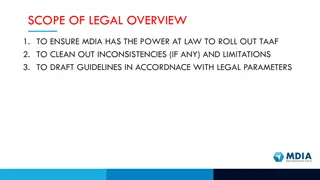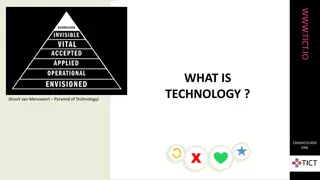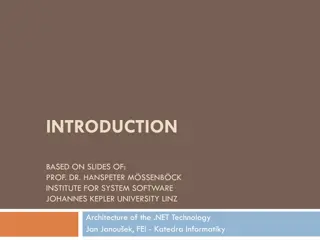Understanding VSAT Technology and Applications
Very Small Aperture Terminal (VSAT) technology revolutionized satellite communications by enabling smaller, more cost-effective earth stations. This article covers the basics of VSAT, its components, advantages, disadvantages, network topologies, and a practical example of its application in KSA. It also explains the evolution from large earth stations to compact VSAT systems, along with the frequencies used in VSAT transmissions.
Download Presentation

Please find below an Image/Link to download the presentation.
The content on the website is provided AS IS for your information and personal use only. It may not be sold, licensed, or shared on other websites without obtaining consent from the author. Download presentation by click this link. If you encounter any issues during the download, it is possible that the publisher has removed the file from their server.
E N D
Presentation Transcript
VSAT Abdullah Saad Ahmed Alqahtani (202322135) AVP4/ VSAT 4
Agenda Introduction What is a VSAT? Components of VSAT Uplink & Downlink Satellites used in the VSAT system Advantages and Disadvantages VSAT Network Topologies Example for using VSAT in KSA Summary References AVP4/ VSAT 5
Introduction The old earth stations and antennas were large sizes. The Satellite was suffering from weak transmission and the impact of higher noise on the ground stations. So the receiving stations must be large size and complex installation. These satellites have developed and become a high transmitter. So the ground stations changed to small size Stations with less expensive and less complex and called VSAT. AVP4/ VSAT 6
What is a VSAT? A very small aperture terminal (VSAT) is a small telecommunication earth station that receives and transmits data, video or voice via satellite. The "very small" component of the VSAT acronym refers to the size of the VSAT dish antenna-typically about 60 cm to 3.8m. vsat_satellite_dish AVP4/ VSAT 7
Components of VSAT It has two basic components: Ground Segment (earth segment), which is divided into: - Outdoor Unit (ODU), which contains the antenna. - Indoor Unit (IDU), which contains the interface between the VSAT and the customer s Equipment (PCs, TVs, Telephones). Space Segment namely satellite. AVP4/ VSAT 8
http://videoblogmarketing.com/wp-content/uploads/2010/03/web-video-icon.jpghttp://videoblogmarketing.com/wp-content/uploads/2010/03/web-video-icon.jpg AVP3/ANTENNA 9
Uplink & Downlink VSAT uses different frequencies: Ku-band frequency: is usually used in North America and Europe by using small VSAT antenna with uplink frequency about 18 GHz and downlink around 12 GHz. C-bandfrequency: is usually used in Asia, Africa and South America and operating with much larger antenna, with uplink frequency around 6 GHz as for downlink frequency around 4 GHz. The new Ka-bandfrequency: is typically in the downlink frequencies up to 22 GHz and uplink frequencies up to 31 GHz. AVP4/ VSAT 9
The satellites that are used in the VSAT system? VSAT system used geostationary earth orbit (GEO) satellites that revolve around the equator at the same rotational speed as the earth. Appearing as though they are not moving at all, GEOs are always in the same place above the earth. They also cover a large geographic area. Direction from earth: 36,000 km (22,282 miles). Speed: 11,300 Km/h. AVP4/ VSAT 10
VSAT Advantages: High flexibility to increase the size of the network in the future. Able to integrate large number of the networks. Cover distant geographical locations. Ability to handle Voice, Video and Data. VSAT Disadvantages: Requires clear line of sight between dish and satellite. Outages in some cases, because of the weather. These outages normally last for a few minutes. AVP4/ VSAT 11
Group work 7min AVP4/ VSAT 12
VSAT Network Topologies The connection between Terminal and Terminal called (Point to Point). The connection between Hub and Terminals called (Point to Multipoint). The most important types of link are: - Star Topology. - Mesh Topology. AVP4/ VSAT 13
Star Topology VSAT terminals cannot communicate directly with each other, they have to go through the hub. It is commonly used for internet connection purpose. Smaller VSAT antenna sizes (1.8 m typically). The performance of the network is directly dependent on the performance of the hub. AVP4/ VSAT 14
Mesh Topology This network enables direct communication from one point to another. Its usually found in telephone and data lines. larger VSAT antenna sizes (3.8 m typically). If one of the components fails there is another line. AVP4/ VSAT 15
Example for using VSAT in KSA Saudi Post Electronic Network. To connect 1230 post offices. http://www.sp.com.sa/_layouts/inc/sp/sp-ar/images_new/sp-logo.jpg During 2005, 37 postal sites were connected to the network in order to use some of the postal applications. AVP4/ VSAT 16
7min AVP4/ VSAT 17
Summary VSAT is a perfect solution in answering voice, data and video, especially in the absence of terrestrial transmission coverage. Utilizing VSAT offers maximum benefit, which enables company to expand very fast without affected by lack of local telecommunication network infrastructure. VSAT is available anywhere in the Kingdom with the ability to connect remote areas. AVP4/ VSAT 18
References http://www.techopedia.com/definition/5095/very- small-aperture-terminal-vsat http://www.satkomindo.com/vsat.html http://www.networkmagazineindia.com/200206/case 1.shtml AVP4/ VSAT 19
Thank you for your attention AVP4/ VSAT 20


![READ⚡[PDF]✔ Solar Sailing: Technology, Dynamics and Mission Applications (Spring](/thumb/21622/read-pdf-solar-sailing-technology-dynamics-and-mission-applications-spring.jpg)




















